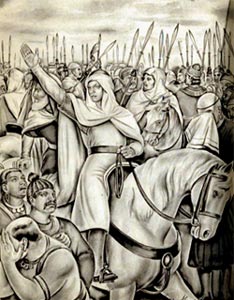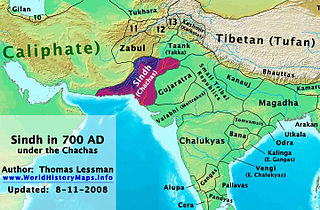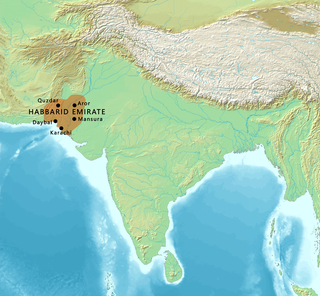
Year 711 (DCCXI) was a common year starting on Thursday of the Julian calendar. The denomination 711 for this year has been used since the early medieval period, when the Anno Domini calendar era became the prevalent method in Europe for naming years.

Muḥammad ibn al-Qāsim al-Thaqafī was an Arab military commander in service of the Umayyad Caliphate who led the Muslim conquest of Sindh, inaugurating the Umayyad campaigns in India. His military exploits led to the establishment of the Islamic province of Sindh, and the takeover of the region from the Sindhi Brahman dynasty and its ruler, Raja Dahir, who was subsequently decapitated with his head sent to al-Hajjaj ibn Yusuf in Basra. With the capture of the then-capital of Aror by Arab forces, Muhammad ibn al-Qasim became the first Muslim to have successfully captured Indian land, which marked the beginning of Muslim rule in South Asia.

Abu Muhammad al-Hajjaj ibn Yusuf ibn al-Hakam ibn Abi Aqil al-Thaqafi, known simply as al-Hajjaj ibn Yusuf, was the most notable governor who served the Umayyad Caliphate. He began his service under Caliph Abd al-Malik, who successively promoted him as the head of the Caliph's shurta, the governor of the Hejaz in 692–694, and the practical viceroy of a unified Iraqi province and the eastern parts of the Caliphate in 694. Al-Hajjaj retained the last post under Abd al-Malik's son and successor al-Walid I, whose decision-making was heavily influenced by al-Hajjaj, until his death in 714.
Atiyah ibn Sa'd ibn Junādah al‐'Awfi [died 729] was an early Muslim scholar of Islam. He is regarded as a reliable narrator of hadith. An aged supporter of rebels and a Shia notable of the time, a disciple of the companion of Muhammad Jabir ibn Abd Allah al-Ansari and a famous narrator of Hadith, Atiyya ibn Sa'd Awfi was arrested by Muhammad bin Qasim on the orders of Al-Hajjaj and demanded that he curse Ali on the threat of punishment. Atiyya refused to curse Ali and was punished. While Maclean doesn't give the details of the punishment, early historians like Ibn Hajar Al-asqalani and Tabari record that he was flogged by 400 lashes and his head and beard shaved for humiliation and that he fled to Khurasan and returned to Iraq after the ruler had been changed.

The Muslim conquests in the Indian subcontinent mainly took place between the 13th and the 18th centuries. Earlier Muslim conquests in the subcontinent include the invasions which started in the northwestern subcontinent, especially the Umayyad campaigns during the 8th century. Mahmud of Ghazni, Sultan of the Ghaznavid Empire, preserved an ideological link to the suzerainty of the Abbasid Caliphate and invaded vast parts of Punjab and Gujarat during the 11th century. After the capture of Lahore and the end of the Ghaznavids, the Ghurid ruler Muhammad of Ghor laid the foundation of Muslim rule in India in 1192. In 1202, Bakhtiyar Khalji led the Muslim conquest of Bengal, marking the easternmost expansion of Islam at the time.
Raja Dahir was the last Hindu ruler of Sindh. A Brahmin ruler, his kingdom was invaded in 711 CE by the Arab Umayyad Caliphate, led by Muhammad bin Qasim, where Dahir died while defending his kingdom. According to the Chachnama, the Umayyad campaign against Dahir was due to a pirate raid off the coast of the Sindhi coast that resulted in gifts to the Umayyad caliph from the king of Serendib being stolen.

The history of Sindh refers to the history of the Pakistani province of Sindh, as well as neighboring regions that periodically came under its sway.

The Umayyad Dynasty came to rule the Caliphate in 661 CE, and during the first half of the 8th century CE, a series of battles took place in the Indian subcontinent between armies of the Umayyad Caliphate and Indian kingdoms situated to the east of the Indus river, subsequent to the Arab conquest of Sindh in present-day Pakistan during 711 – 713 CE.

The Habbari were an Arab dynasty that ruled much of Greater Sindh, as a semi-independent emirate from 854 to 1024. Beginning with the rule of 'Umar bin Abdul Aziz al-Habbari in 854 CE, the region became semi-independent from the Abbasid Caliphate in 861, while continuing to nominally pledge allegiance to the Abbasid Caliph in Baghdad. The Habbari ascension marked the end of a period of direct rule of Sindh by the Umayyad and Abbasid Caliphates, which had begun in 711 CE.

Mansura, referred to as Brahmanabad in later centuries, was the historic capital of the caliphal province of Sindh, during the eighth century under the Umayyad Caliphate and then Abbasid Caliphate from the year 750 AD to 1006 AD. The city was founded as a central garrison by the Umayyad Forces in Sindh, the city transformed into a very vibrant metropolis during the Abbasid Era surpassing the wealth of Multan in the north and Debal in the south. Mansura was the first capital established by the Muslims in the Indian subcontinent after Muhammad bin Qasim seized the Brahmanabad territory. Mansura was built on the shores of the Indus River, it was surrounded by fertile farmland, Ibn Hauqal mentioned the wealthy local merchants who wore Baghdad Costume and were of Sindhi-Arab origins, houses were made of clay, baked bricks and plaster.
The Sun Temple of Multan was a temple dedicated to Surya, the Hindu Sun God, in the city of Multan in modern Pakistan. The location of the temple remains unknown; it is distinct from the Prahladpuri Temple.
Sind was an administrative division of the Umayyad Caliphate and later of the Abbasid Caliphate in post-classical India, from around 711 CE with the Umayyad conquest of Sindh by the Arab military commander Muhammad ibn al-Qasim, to around 854 CE with the emergence of the independent dynasties of the Habbarid Emirate and the Emirate of Multan. The "Governor of Sind" was an official who administered the caliphal province over what are now Sindh and South Punjab in Pakistan, with Makran in Balochistan also usually being under his control.
Hindu Rajput kingdoms in the north-western Indian subcontinent resisted the Muslim invasions of India, beginning with the Umayyad campaigns from the Middle East and the Ghaznavid Turks from Central Asia. They continued resistance against subsequent Muslim empires, including the Arabs, Ghaznavids, Ghurids, Delhi Sultans and the Mughals.

The Brahmin dynasty of Sindh, also known as the Chacha dynasty, was the ruling dynasty of the Sindh, succeeding the Rai dynasty. Most of the information about its existence comes from the Chach Nama, a historical account of the Chach-Brahmin dynasty.

The Arab Empire maintained and expanded a wide trade network across parts of Asia, Africa and Europe. This helped establish the Arab Empire as the world's leading economic power throughout the 8th–13th centuries according to the political scientist John M. Hobson. It is commonly believed that Mu‘awiya Ibn Abi Sufyan was the first planner and establisher of the Islamic navy.
Gandavah is a town that serves as the headquarters of Jhal Magsi District of Pakistan's Balochistan province. Located on a small hill in the middle of the Kach Gandava plain, Gandava is inhabited by a mix of Sindhi, Baloch, Pathan, Brahui, and Hindu communities. The town has a long history and several old architectural monuments including the Moti Gohram tomb, locally known as "the Taj Mahal of Baluchistan". Gandava also faces significant difficulties with needs like water, electricity, gas, healthcare, and education. As of the 2017 Census of Pakistan, Gandava Municipal Corporation has a population of 7,825 people, in 1,256 households.Gandawa was one of the provincial headquarters of the Bhil dynasty of India

The Umayyad conquest of Sindh took place in 711 AD against the ruling Brahmin dynasty of Sindh and resulted in Sindh being incorporated as a province into the Umayyad Caliphate. The conquest resulted in the overthrow of the last Hindu dynasty of Sindh, the Brahman dynasty, after the death of Raja Dahir.
Surya Devi, was an Indian princess.

The Battle of Aror, also known as the Battle of Rewar, took place in 711 AD between the Umayyad forces under Muhammad ibn al-Qasim and the army of Brahmin dynasty of Sindh under Raja Dahir. It was the last military conflict of Raja Dahir, in which the Umayyads defeated his army near Indus river and resulted in the death of Dahir.













